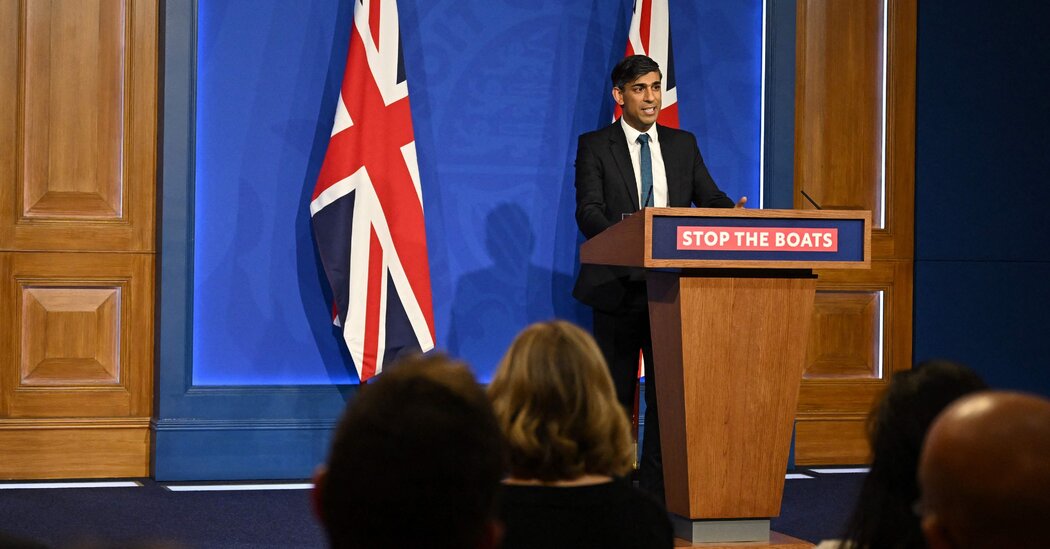Net legal migration into Britain climbed to almost three-quarters of a million people in 2022, official statistics showed on Thursday, a new and unwelcome record for the country’s governing Conservative Party after it promised to use its post-Brexit powers to curb the number of arrivals.
The figures were a fresh setback for the prime minister, Rishi Sunak, prompting anger within his party, as he also struggles to stop asylum seekers arriving in small boats on the British coast, revive a slumbering economy and deal with dismal polling numbers.
“In every election since 1992 we have promised to reduce migration,” Neil O’Brien, a Conservative lawmaker and Brexit supporter, said on social media, adding that Thursday’s “extraordinary numbers” meant that the prime minister “must now take immediate and massive action.”
The figures, released by the country’s official statistical agency, revised the net migration total for the year ending December 2022 — previously estimated at 606,000, itself a record — upward to 745,000.
The statistics relate to people given permission to enter the country, mainly to work or study. The majority now come from countries outside Europe, and the trend is politically awkward for supporters of Brexit — including Mr. Sunak. During the 2016 referendum campaign, those advocating departure promised to “take back control” of the country’s borders.
But far from immigration falling, as many had expected, the number of people arriving in the country legally has more than doubled since Brexit, even as Britons lost their automatic right to live and work elsewhere in Europe.
No longer able to recruit freely from their near neighbors, British employers have looked further afield, including to Asia, Africa and the Middle East, to fill gaps in the labor market, which emerged in areas such as health care and hospitality as the coronavirus pandemic receded. There has also been a big rise in the number of overseas students from countries outside Europe.
Some of those increases are likely to be temporary, but the rise has stirred tensions within the Conservative Party, which promised, when it took power 13 years ago, to limit net migration to tens of thousands of people a year.
A Conservative lawmaker, Jonathan Gullis, told Times Radio that the rise was “completely unacceptable and it will be unacceptable as well to the majority of the British people.” He called on the prime minister and the home secretary “to take drastic action now” as well as “stopping the boats.” Although a highly visible symbol of Britain’s inability to control its frontiers, the number of people crossing on small boats is a fraction of the number arriving legally; last year’s total amounted to around 46,000.
According to opinion polls, migration had fallen down the list of concerns for most Britons in recent years. The state of the economy and health care are more of a worry, despite a slight uptick recently, and polls show more Britons consider immigrants to make a positive contribution to their society.
On Thursday James Cleverly, the home secretary appointed last week after the firing of Suella Braverman, a hard-line champion of immigration restrictions, said that the government “remains completely committed to reducing levels of legal migration while at the same time focusing relentlessly on our priority of stopping the boats.” But he also echoed what many economists have pointed out — that Britain relies on migrant workers in many sectors, particularly health and social care.
“The biggest drivers of immigration to the U.K. are students and health care workers,” Mr. Cleverly said, adding that this was “testament to both our world-leading university sector and our ability to use our immigration system to prioritize the skills we need.”
Keir Starmer, leader of the opposition Labour Party, described the migration numbers as “shockingly high” and “a failure not just of immigration, but also of asylum and of the economy.”
Provisional figures for the year ending June 2023 showed a slight decline from the recent peak, with around 968,000 non-European arrivals, 129,000 from the 27-nation European Union and around 84,000 Britons returning.
Slightly more than half a million people emigrated during the same period, leaving net migration at 672,000, though this, too, is subject to revision.
Earlier this year Mr. Sunak said that the numbers were “too high, it’s as simple as that,” and that he wanted to bring them down. But with labor shortages hampering economic growth, he faces pressure from employers including in health care and hospitality who have pressed for visas to recruit foreign workers.
In the year to June 2023, the top five non-European nationalities for immigration flows into Britain were Indian (253,000), Nigerian (141,000), Chinese (89,000), Pakistani (55,000) and Ukrainian (35,000). That underscored the striking change in the profile of migration since Brexit and the reduction in the flow of people from continental Europe.
To try to push the numbers downward, the government said earlier this year that it would prevent the majority of international students from bringing family members into the country.
The government says that the impact of those changes has yet to be felt. But migration has become an increasingly sensitive issue in recent months, in part because the government chose to make “stopping the boats” one of its key pledges — a goal it has proved unable to meet.
Last week, Britain’s Supreme Court rejected a government plan to deport asylum seekers to Rwanda for processing, where they would live even if they were granted asylum, saying it would breach domestic and international human rights law. Mr. Sunak has since promised a new agreement with Rwanda, and new emergency legislation to override the court.


